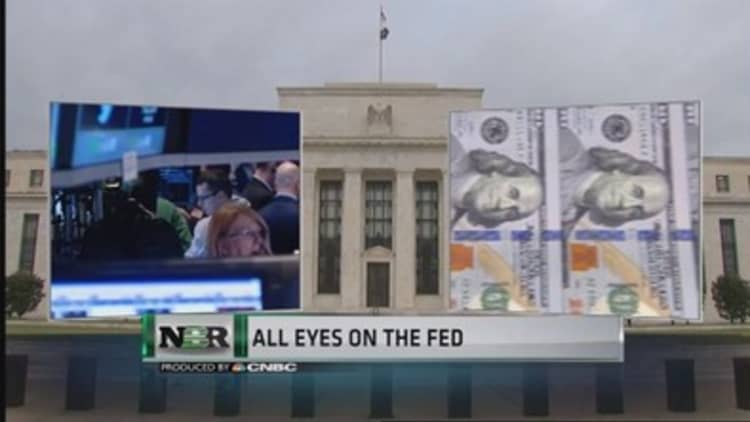


The long-awaited statement from the Federal Reserve expected on Wednesday will settle the burning investor question of whether or not "patient" remains in the text. A change in the keyword could shed light on when rates might rise for the first time in nearly a decade.
Most analysts believe employment data indicate an improving economy and provide impetus for a rate hike this year.
"Payrolls data has continued to chug along quite well," said Bill Stone, chief investment officer at PNC Wealth Management. His firm expects a rate hike in July as it sees the recent softness in economic data as due partly to the harsh winter and the "the normal ebb and flow of economies."
The Federal Open Market Committee is scheduled to conclude its two-day meeting on Wednesday, with its highly anticipated statement expected at 2 p.m. EDT and a press conference at 2:30 p.m. Investors are looking at whether or not "patient" remains in the text as an indication of when short-term interest rates might go up.
"I think we're probably close to consensus that we expect them to take 'patience' out," Stone said. That language change "starts the clock a bit" for a rate increase, he said.
After February's nonfarm payrolls data, which was a second-consecutive strong report, stocks swung upward or downward in the days following as investors weighed the impact of mixed economic figures on a Fed move.
In particular, the Dow Jones industrial average had nine triple-digit closes in the last two weeks, four up and five down.
While equities fluctuate, the CBOE Volatility Index (.VIX), considered the best gauge of fear in the market, has traded below 16, lower than expected levels of 19 to 20.
"You thought with such as strong rally (on Monday) it would have come off more," said JJ Kinahan, chief derivatives strategist at TD Ameritrade. "The risk-on trade is basically still there."
The U.S. 10-year Treasury yield held lower on Tuesday at 2.05 percent, while the shorter-term two-year yield climbed to 0.67 percent.
Read MoreDalio: We're 'cautious' ahead of Fed rate liftoff
Futures imply an increase in rates in September with 60.99 percent probability, according to CME Group data. Economists, analysts and money mangers polled by CNBC expect a rate increase in August.
In the little economic data out on Tuesday, housing starts fell 17 percent in February. The 3 percent increase in building permits indicated to most analysts that the drop was seasonal.
Investors will get more insight on the housing market with weekly mortgage applications due at 7 a.m. on Wednesday.
"I think (near zero) rates right now is distorting capital and currency markets," said Jack Ablin, chief investment officer at BMO Private Bank. He "would like to get back to normal rather than these abnormal money conditions."
He said that easing has boosted the equity market as stocks climb higher. But the lack of fundamental economic benefit, in his view, has created "bubble material."
The major U.S. indexes held on to gains for the year Tuesday, but only the Nasdaq closed in the black.
The Dow closed down 128.34 points, or 0.71 percent, at 17,849.08.
The S&P 500 fell 6.91 points, or 0.33 percent, to 2,074.28. The rose 7.93 points, or 0.16 percent, at 4,937.43.
In the commodities market, oil extended declines with crude settling down 42 cents at $43.46 a barrel, the lowest since March 2009.
Crude oil continued to fall late on Tuesday after American Petroleum Institute data showed a larger-than-expected increase in crude inventories, up 10.5 million barrels versus the StreetAccount consensus for 3.07 million barrels.
Investors will watch weekly oil inventories from the U.S. Energy Information Administration, expected Wednesday morning, for further indications on supply.
"If oil continues to fall from there to below $40 a barrel, (it could hit) a lot of leveraged oil companies up and down the production line," said Bruce Bittles, chief investment strategist at RW Baird. "Otherwise, it's a big, big tax cut. More positive than negative."
Unlike most analysts, Bittles expects the weaker economic data to push an interest rate hike to early next year rather than this summer.
Gold futures also extended losses, settling down $5 at $1,148.20 an ounce on Tuesday. The dollar took a break from its rally, as the euro briefly topped $1.06.
Despite the recent negative correlation between U.S. stocks and the strong dollar, several analysts said investors should look beyond currency fluctuations.
Read MoreWhy the euro's next move may shock the Street
"We do not think the strong U.S. dollar will derail the bull market," Burt White, chief investment officer for LPL Financial, wrote in a note. "The dollar itself is not a key driver of market performance; it is a symptom."
Correction: This story has been updated to reflect that CME Group futures implied an interest rate hike in September.


